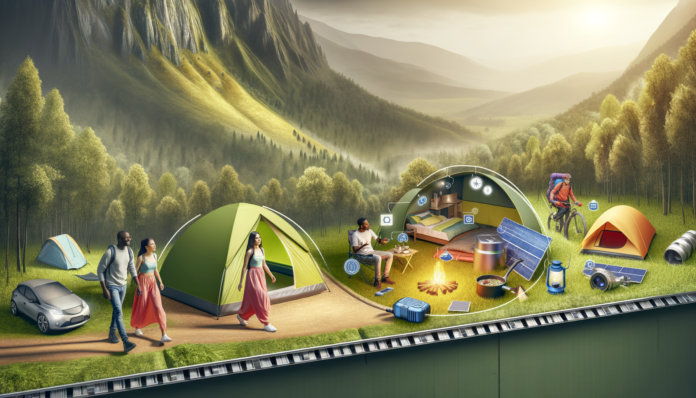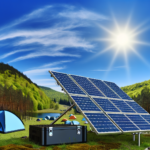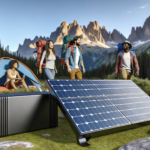Introduction
The Growing Popularity of Outdoor Activities
In recent years, there has been a significant surge in the popularity of outdoor activities. From hiking and camping to boating and off-grid living, more people are seeking solace and adventure in nature. This trend is driven by a variety of factors, including the desire for physical fitness, mental well-being, and a deeper connection with the natural world. The COVID-19 pandemic has further accelerated this movement, as people look for safe and socially distanced ways to enjoy their leisure time. According to a report by the Outdoor Industry Association, participation in outdoor activities increased by 7.1% in 2020, with millions of new enthusiasts joining the ranks of seasoned adventurers.
The Need for Sustainable Solutions
As the popularity of outdoor activities grows, so does the need for sustainable solutions. The environmental impact of increased human activity in natural spaces cannot be ignored. Traditional outdoor gear and practices often rely on non-renewable resources and can contribute to pollution and habitat destruction. For instance, the use of disposable batteries, fossil fuel-powered generators, and single-use plastics are common in outdoor settings, leading to significant waste and carbon emissions. To mitigate these effects, there is a pressing need for innovative, eco-friendly technologies that allow people to enjoy the great outdoors while minimizing their environmental footprint.
Purpose and Scope of the Article
This article aims to explore how advancements in technology, particularly solar power, are revolutionizing the way we experience the great outdoors. We will delve into the historical evolution of outdoor technology, highlighting key innovations that have transformed outdoor experiences. The focus will then shift to solar power, examining its benefits and various applications in outdoor activities such as camping, hiking, boating, and off-grid living. Additionally, we will provide guidance on choosing the right solar power solutions, including factors to consider, durability, efficiency, and customer feedback. Finally, we will discuss maintenance best practices and future trends in outdoor solar technology, emphasizing sustainability and emerging innovations.
By the end of this article, readers will have a comprehensive understanding of how solar power and other technological advancements are making outdoor activities more sustainable, enjoyable, and accessible. Whether you are a seasoned adventurer or a newcomer to the world of outdoor exploration, this guide will equip you with the knowledge to make informed decisions and embrace eco-friendly practices in your outdoor pursuits.
The Evolution of Outdoor Technology
Historical Perspective
The journey of outdoor technology has been a fascinating one, marked by significant milestones that have transformed how we interact with nature. In the early days, outdoor enthusiasts relied on rudimentary tools and gear. Leather boots, woolen clothing, and simple canvas tents were the norm. These items, while functional, were heavy and often not very durable. The advent of vulcanized rubber in the 1930s, pioneered by Vibram, revolutionized footwear by providing better grip and durability, making outdoor activities safer and more accessible.
The 1960s and 70s saw the introduction of synthetic materials like nylon and Gore-Tex, which offered lightweight, waterproof, and breathable options for outdoor gear. This period also witnessed the development of internal-frame backpacks by Greg Lowe, which significantly improved load distribution and comfort for hikers. These innovations laid the groundwork for the modern outdoor experience, making it more comfortable and accessible to a broader audience.
Modern Innovations
Today, the outdoor industry is at the forefront of technological innovation, integrating advanced materials and digital solutions to enhance the outdoor experience. One of the most significant advancements is the use of 3D printing technology. Companies like Osprey and Carbon are utilizing 3D printing to create customized, ergonomic gear that offers unparalleled comfort and performance. For instance, Osprey’s UNLTD Antigravity 64 pack features 3D-printed lumbar pads that adapt to the user’s body shape, providing superior support and breathability.
Wearable technology has also made significant strides. Devices like Garmin’s GPS watches and Core’s body temperature monitors provide real-time data that helps outdoor enthusiasts navigate, monitor their health, and optimize their performance. These devices are becoming increasingly sophisticated, offering features like weather forecasting, route planning, and even emergency alerts.
Moreover, artificial intelligence (AI) is revolutionizing gear design and personalization. AI algorithms analyze user data to create customized gear that meets individual needs, from tailored hiking boots to optimized camping equipment. This level of personalization ensures that outdoor enthusiasts have the best possible experience, tailored to their specific requirements.
Impact on Outdoor Experiences
The impact of these technological advancements on outdoor experiences is profound. Modern gear is not only more comfortable and durable but also significantly enhances safety. For example, GPS devices and satellite communication tools allow adventurers to explore remote areas with the confidence that they can call for help if needed. This has opened up new possibilities for exploration and adventure, making it feasible to venture into previously inaccessible regions.
Digital platforms and apps have also transformed how we plan and execute outdoor activities. Apps like AllTrails and Gaia GPS provide detailed maps, trail information, and user reviews, making it easier to plan trips and navigate trails. These tools have democratized access to the outdoors, allowing even novice adventurers to embark on complex journeys with confidence.
Furthermore, the integration of sustainable technologies is helping to minimize the environmental impact of outdoor activities. Solar-powered gear, eco-friendly materials, and waste-reducing designs are becoming standard, reflecting a growing awareness of the need to protect the natural environments we enjoy.
In summary, the evolution of outdoor technology has made outdoor activities more accessible, enjoyable, and safe. From the early days of basic gear to today’s high-tech innovations, technology continues to revolutionize the way we experience the great outdoors, promising even more exciting developments in the future.
Solar Power: A Game Changer
Introduction to Solar Power
Solar energy, simply put, is energy harnessed from the sun. It’s an endless, powerful stream of light and heat, and it’s the most abundant energy resource on our planet. With approximately 173,000 terawatts of solar energy striking the Earth continuously, this is more than 10,000 times the world’s total energy use. Solar panels, which convert sunlight into electricity through the photovoltaic effect, are the primary technology used to capture this energy. Among the latest advancements in this field are flexible solar panels, which are lightweight, bendable, and highly portable, making them ideal for outdoor applications.
Benefits of Solar Power for Outdoor Enthusiasts
For outdoor enthusiasts, the benefits of solar power are immense. Here are some key advantages:
- Portability: Modern solar panels, especially flexible ones, are designed to be lightweight and easy to transport. This makes them perfect for activities like camping, hiking, and boating.
- Renewable and Sustainable: Solar energy is a renewable resource, meaning it won’t run out. Using solar power reduces reliance on fossil fuels, helping to mitigate environmental impact.
- Cost-Effective: After the initial investment in solar panels, the cost of solar energy is practically free. This can significantly reduce electricity bills and the need for other power sources.
- Environmentally Friendly: Solar panels produce clean energy without emitting harmful gases, reducing the carbon footprint and promoting a healthier environment.
- Reliability: With solar power, outdoor enthusiasts can have a reliable source of energy even in remote locations, ensuring that essential devices remain powered.
Types of Solar Power Solutions
There are various types of solar power solutions available, each catering to different needs and applications:
Portable Solar Panels
Portable solar panels are compact and designed for easy transport. They can be folded or rolled up, making them ideal for backpacking, camping, and other outdoor activities. These panels can charge small devices like smartphones, GPS units, and cameras.
Flexible Solar Panels
Flexible solar panels are a recent innovation in the solar industry. They are lightweight, bendable, and can conform to curved surfaces. This versatility makes them suitable for a wide range of applications, from attaching to backpacks to mounting on boats and RVs.
Solar Power Banks
Solar power banks combine solar panels with battery storage, allowing users to store energy for later use. These are particularly useful for charging devices at night or during cloudy weather when direct sunlight is not available.
Solar Generators
Solar generators are larger systems that can power more substantial equipment, such as refrigerators, lights, and even small appliances. They are ideal for extended camping trips, RVing, and living off-grid.
Integrated Solar Solutions
Some products integrate solar panels directly into outdoor gear, such as solar-powered tents, backpacks, and clothing. These innovative solutions provide a seamless way to harness solar energy while on the move.
In conclusion, solar power is revolutionizing the way outdoor enthusiasts experience nature. With its portability, sustainability, and cost-effectiveness, solar energy provides a reliable and environmentally friendly power source for a wide range of outdoor activities. Whether you’re camping, hiking, boating, or living off-grid, there’s a solar power solution to meet your needs.
Implementing Solar Solutions in Outdoor Activities
Camping
Camping has always been a favorite outdoor activity, and the integration of solar power has made it even more enjoyable and sustainable. **Portable solar panels** and **solar-powered camping gear** are revolutionizing the way campers experience the great outdoors. Lightweight and compact solar panels can be easily packed and set up at campsites, providing a reliable source of energy for charging devices, lighting, and even cooking.
*Solar-powered tents* and *backpacks* are also gaining popularity. These innovative products come with built-in solar panels that can charge electronic devices, ensuring that campers stay connected and safe. Additionally, solar-powered lanterns and string lights offer eco-friendly lighting solutions, enhancing the camping experience without the need for traditional batteries or fuel.
Hiking
Hiking enthusiasts can greatly benefit from solar power solutions, especially when venturing into remote areas where access to electricity is limited. **Solar chargers** and **portable power banks** are essential tools for hikers, allowing them to keep their GPS devices, smartphones, and cameras charged throughout their journey.
Solar-powered backpacks are particularly useful for hikers. These backpacks come equipped with solar panels that can charge devices on the go, ensuring that hikers have a constant supply of power. This is not only convenient but also enhances safety by keeping communication devices operational in case of emergencies.
Boating
For boating enthusiasts, solar power offers a sustainable and cost-effective alternative to traditional fuel sources. **Solar panels** can be installed on boats to provide a steady supply of energy for various needs, including navigation systems, lighting, and refrigeration. This reduces the reliance on fossil fuels and minimizes the environmental impact of boating activities.
Solar power is also ideal for powering **emergency communication devices** and **safety equipment** on boats. In case of an emergency, having a reliable source of power can be a lifesaver, ensuring that communication devices remain functional and help is on the way.
Living Off-Grid
Living off-grid is becoming increasingly popular as people seek to reduce their carbon footprint and embrace a more sustainable lifestyle. Solar power is a key enabler of off-grid living, providing a reliable and renewable source of energy for various needs.
**Solar panels** can be used to power homes, cabins, and other off-grid structures, providing electricity for lighting, heating, and appliances. **Solar water heaters** and **solar-powered water pumps** are also essential for off-grid living, ensuring a steady supply of hot water and irrigation for gardens and crops.
Moreover, solar power can be used to charge **electric vehicles** and **portable power stations**, making off-grid living more convenient and sustainable. By harnessing the power of the sun, individuals can enjoy the freedom and independence of off-grid living while minimizing their environmental impact.
Choosing the Right Solar Power Solution
Factors to Consider
When selecting a solar power solution for your outdoor activities, several factors should be taken into account to ensure you make the best choice. **Purpose** is paramount; determine whether you need the solar power for camping, hiking, boating, or living off-grid. Each activity has unique power requirements and constraints. **Budget** is another critical factor, as solar power solutions can range from affordable to high-end. **Energy needs** should be assessed by calculating the total wattage of the devices you plan to power. Lastly, consider the **environmental conditions** where you will be using the solar panels, such as exposure to sunlight, temperature variations, and potential for physical damage.
Durability and Portability
**Durability** and **portability** are essential characteristics of a good solar power solution, especially for outdoor enthusiasts. Look for solar panels that are built to withstand harsh weather conditions, including rain, snow, and extreme temperatures. Materials like tempered glass and corrosion-resistant aluminum frames can enhance durability. **Portability** is equally important, particularly for activities like hiking and camping where weight and space are limited. Foldable and lightweight solar panels, such as those offered by BougeRV, are ideal for these scenarios. They can be easily packed and transported, ensuring you have a reliable power source wherever you go.
Efficiency and Capacity
The **efficiency** and **capacity** of solar panels are crucial for meeting your energy needs. **Efficiency** refers to how well the solar panels convert sunlight into usable electricity. High-efficiency panels, often made with monocrystalline cells, are more effective in low-light conditions and require less space. **Capacity** is measured in watt-hours (Wh) and indicates how much energy the system can store and deliver. For instance, a 200-watt solar panel can generate approximately 800-1,200 watt-hours per day, depending on sunlight availability. Ensure that the capacity aligns with your daily energy consumption to avoid running out of power during your outdoor adventures.
Customer Reviews and Feedback
Before making a purchase, it’s wise to consult **customer reviews and feedback**. These can provide valuable insights into the real-world performance and reliability of the solar power solutions you are considering. Look for reviews that discuss the ease of installation, durability, and actual efficiency of the panels. Pay attention to any recurring issues or complaints, as these can be red flags. Additionally, consider feedback on customer service and warranty support, as these factors can significantly impact your overall satisfaction with the product. Websites like Amazon, specialized forums, and review aggregators are excellent resources for gathering this information.
By carefully considering these factors, you can choose a solar power solution that not only meets your energy needs but also enhances your outdoor experiences, making them more sustainable and enjoyable.
Maintenance and Best Practices
Proper Usage
To maximize the benefits of solar power solutions in outdoor activities, it is essential to understand and adhere to proper usage guidelines. **Proper usage** ensures that your solar equipment operates efficiently and has a longer lifespan. Here are some key points to consider:
- Positioning: Place solar panels in areas with maximum sunlight exposure. Avoid shaded spots as they can significantly reduce the efficiency of solar power generation.
- Angle Adjustment: Adjust the angle of the solar panels according to the sun’s position. This can be particularly important during different seasons to capture the most sunlight.
- Battery Management: Use the solar power system’s battery management features to prevent overcharging or deep discharging, which can damage the battery.
- Load Management: Be mindful of the power consumption of connected devices. Overloading the system can lead to inefficiencies and potential damage.
Maintenance Tips
Regular maintenance is crucial to ensure the longevity and optimal performance of your solar power solutions. Here are some maintenance tips to keep your system in top shape:
- Cleaning: Dust, dirt, and debris can accumulate on solar panels, reducing their efficiency. Clean the panels regularly with a soft cloth and mild detergent to maintain optimal performance.
- Inspection: Periodically inspect the solar panels, wiring, and connections for any signs of wear or damage. Address any issues promptly to prevent further complications.
- Battery Care: Check the battery terminals for corrosion and clean them if necessary. Ensure that the battery is stored in a cool, dry place to prevent overheating and prolong its life.
- Firmware Updates: If your solar power system includes smart features, keep the firmware updated to benefit from the latest improvements and bug fixes.
Troubleshooting Common Issues
Even with proper usage and maintenance, you may encounter some common issues with your solar power solutions. Here are some troubleshooting tips to help you address these problems:
- Low Power Output: If you notice a drop in power output, check for obstructions blocking sunlight from reaching the panels. Clean the panels and ensure they are positioned correctly.
- Battery Not Charging: If the battery is not charging, inspect the connections between the solar panels and the battery. Ensure that all connections are secure and free from corrosion.
- System Overload: If the system shuts down due to overload, disconnect some devices and restart the system. Consider upgrading to a higher capacity system if you frequently experience overloads.
- Inconsistent Performance: Inconsistent performance can be due to fluctuating sunlight conditions. Ensure that the panels are not shaded and that they are positioned to capture maximum sunlight throughout the day.
By following these best practices for proper usage, maintenance, and troubleshooting, you can ensure that your solar power solutions remain reliable and efficient, enhancing your outdoor experiences while promoting sustainability.
Future Trends in Outdoor Solar Technology
Emerging Technologies
The landscape of outdoor solar technology is rapidly evolving, driven by continuous advancements and innovative solutions. One of the most exciting developments is the advent of **flexible solar panels**. Unlike traditional rigid panels, these are lightweight, bendable, and can be easily integrated into various outdoor gear and surfaces. This flexibility opens up a myriad of applications, from attaching panels to backpacks for hikers to installing them on curved surfaces of boats and RVs.
Another promising technology is **solar fabric**. This material can be woven into tents, awnings, and even clothing, providing a seamless way to harness solar energy without the need for separate panels. Imagine a camping tent that not only provides shelter but also powers your devices!
**Solar-powered batteries** are also seeing significant improvements. These batteries are becoming more efficient, with faster charging times and greater storage capacities, ensuring that outdoor enthusiasts have a reliable power source even during extended trips.
Sustainability and Environmental Impact
The push towards sustainability is a major driving force behind the adoption of solar technology in outdoor activities. Solar power is a **renewable energy source**, meaning it doesn’t deplete natural resources or produce harmful emissions. This makes it an environmentally friendly alternative to traditional fossil fuels.
Moreover, the production of solar panels is becoming more eco-friendly. Manufacturers are increasingly using **recycled materials** and adopting greener production processes. This not only reduces the carbon footprint of the panels themselves but also promotes a circular economy.
The use of solar power in outdoor activities also helps to preserve natural habitats. By reducing the need for generators and other fuel-based power sources, we can minimize noise pollution and the risk of fuel spills, thereby protecting wildlife and natural landscapes.
Predictions for the Future
Looking ahead, the future of outdoor solar technology is incredibly promising. We can expect to see even more **integration of solar power into everyday outdoor gear**. From solar-powered tents and backpacks to clothing and accessories, the possibilities are endless.
**Efficiency improvements** will continue to be a focal point. Future solar panels will likely be able to capture and convert more sunlight into electricity, even in low-light conditions. This will make solar power a more viable option in a wider range of environments and weather conditions.
**Smart technology** will also play a significant role. Imagine solar panels that can communicate with your devices, optimizing power distribution based on your usage patterns. This kind of intelligent energy management will make outdoor adventures more convenient and sustainable.
In conclusion, the future of outdoor solar technology is bright, with emerging technologies, a strong focus on sustainability, and exciting predictions for continued innovation. As we embrace these advancements, we can look forward to a more sustainable and enjoyable outdoor experience.






